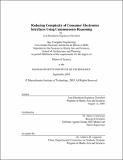Reducing complexity of consumer electronics interfaces using commonsense reasoning
Author(s)
Espinosa Christlieb, José Humberto
DownloadFull printable version (4.112Mb)
Other Contributors
Massachusetts Institute of Technology. Dept. of Architecture. Program In Media Arts and Sciences
Advisor
Henry Lieberman.
Terms of use
Metadata
Show full item recordAbstract
User interfaces to consumer electronics devices - Video recorders, phones, cameras, washing machines, microwave ovens, etc. - are getting too complicated to be easily used by ordinary consumers. We believe that what is responsible for such complication is a design philosophy which simply maps functions the device can perform to controls like buttons and menu items. That leaves the users with the difficult cognitive task of mapping their goals onto the devices' capabilities - a frustrating and error-prone process. Our hypothesis is that we can provide better assistance to the user using Commonsense Reasoning leading to shorter interactions with the devices. Commonsense can infer the users' likely goals from watching their actions, and anticipate what capabilities of the device can fulfill the users' needs. As devices gain networking capabilities and interact with other devices, Commonsense can also help devices cooperate in support of the users' goals.
Description
Thesis (S.M.)--Massachusetts Institute of Technology, School of Architecture and Planning, Program in Media Arts and Sciences, 2005. This electronic version was submitted by the student author. The certified thesis is available in the Institute Archives and Special Collections. Includes bibliographical references (leaves 94-100).
Date issued
2005Department
Program in Media Arts and Sciences (Massachusetts Institute of Technology)Publisher
Massachusetts Institute of Technology
Keywords
Architecture. Program In Media Arts and Sciences